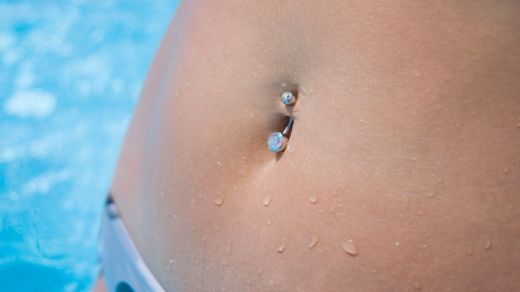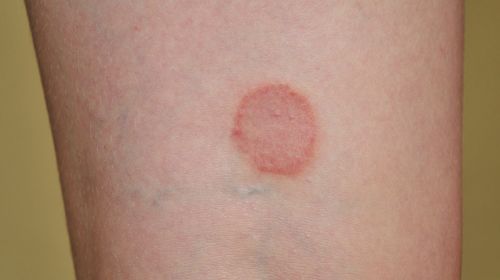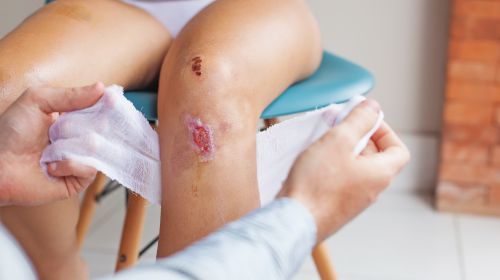Piercings are very popular and widespread. The wound usually heals without complications. In some cases, however, for example due to incorrect after-treatment and care, so-called game meat occurs on the piercing. These are tissue growths. What helps and how can it be prevented?
- © Getty Images/vvs1976
Quick Overview: Venison (Piercing)
What is venison? Venison is also known as wild meat or keloid. It is a benign skin tumor that causes proliferating scar tissue due to impaired wound healing.
Symptoms: Symptoms of game meat on the piercing include a clear elevation of the skin. The scar is thickened and grows beyond the original wound. Sometimes there is pressure pain and itching.
Therapy: There is no single therapy for treating venison in a piercing. Experts usually test different approaches, the treatment is often lengthy.
At a glance:
What is venison on the piercing?
A piercing is a deliberate injury to the skin to attach jewelry. Every skin injury leads to a scar in the healing process, which fades more and more over time and is usually no longer visible at some point.
However, the wound healing process is not always without complications. In some cases, the scar tissue becomes very thick (hypertrophic scar). If it also proliferates over the edges of the wound, experts also speak of a keloid. Colloquially, game meat is spoken of. From a medical point of view, keloids are benign tumors.
Venison usually occurs after an operation or an injury caused by an accident. In addition, scarring on the stoma can occur with an artificial bowel outlet. In addition, game meat occurs, for example, after a piercing, a tattoo and in the context of certain skin diseases such as acne. In very rare cases, the keloid forms spontaneously.
Piercing venison: symptoms
Growing scars are particularly common on the upper half of the body, such as the face and ears. The venison appears bulging and thick, the scarring clearly rises above the skin and continues to spread. At first, the thickening is often reminiscent of a pimple. The color of game meat varies from light pink to deep red and sometimes even turns purple or brownish. The skin at the site feels hard.
The pathological scar change does not recede on its own and can severely limit the lives of those affected, since keloids trigger the following symptoms, among others:
- itching
- feeling of tension
- Pains
- Sensitivity to touch
- sensory disturbances (such as numbness)
In addition, game meat can pose a cosmetic problem and cause psychological distress as a result.
Why does wild meat form on the piercing?
The exact reason why venison develops in some people and not in others is not yet fully understood. However, improper care and irritation of the wound can encourage the growth to occur.
This leads to an increased growth of so-called fibroblasts (cells of the connective tissue) and as a result to an increased formation of collagen. As a result, scar tissue continues to grow and thicken.
In addition, several risk factors can favor the appearance of game meat on the piercing, including:
Skin color: Dark-skinned people are up to 20 times more likely to get venison after a piercing than fair-skinned people.
genetic predisposition: Keloids occur more frequently in some families, which is why a genetic predisposition is likely.
hormones: During pregnancy and during puberty, the risk of venison from a new piercing is increased.
Age: The skin growth is most common in people under the age of 30.
In addition, the location of the puncture channel is crucial: piercings through cartilage tissue are more prone to venison than others.
How is venison treated?
If venison occurs in the course of a piercing, it should not be treated with home remedies yourself. In any case, the first point of contact should be the dermatological practice: the treatment of game meat belongs in the hands of experienced doctors and even then the treatment is often difficult.
The aim of the therapy is to reduce the size and volume of the diseased scar growth and to alleviate the symptoms. In addition, an aesthetic result is sought in order to reduce the level of suffering.
Various therapy options are available to treat game meat. However, there is no standard procedure; rather, it is individually considered which method is suitable.
Possible treatment methods for game meat are:
Cortisone: Corticosteroids reduce inflammation and reduce scar growth. They are available as an ointment and cream, as an injection or as a tablet for oral use. Creams and ointments are not recommended in the case of proliferations of wild meat; cortisone injections, which are injected directly into the proliferating scar on the piercing, are more suitable for treatment. At the beginning of the therapy, cortisone is given every 2 to 3 weeks, and the intervals are increased over the course of time.
Cryosurgery: Cryosurgery is often combined with cortisone therapy. The scarred tissue is treated with very cold, liquid nitrogen and thus frozen. This often leads to shrinkage of the game meat.
Pressure treatment: Compression therapy is one of the most common therapy methods. For example, special pressure bandages are used.
Surgery: Surgery to remove the keloid is unsuitable as the sole therapy, since in many cases the venison returns and often spreads even more. However, such an intervention can be considered in combination with other procedures, such as cortisone.
Laser therapy: Laser therapy is suitable for removing the diseased scars layer by layer, but the recurrence rate is also very high here.
Radiotherapy: Radiation therapy is used, for example, when wild flesh proliferates over a large area: the treatment reduces scar growth and is mainly carried out after an operation. The tissue is irradiated for a few minutes in several sessions.
Silicone: Silicone pads, discs and creams have long been used to treat scar hypertrophy and keloids. These are applied to affected areas and can help reduce the growth, especially in the early stages of scarring. In the case of existing game meat, however, they are unsuitable as the only therapy. Silicone discs for treating game meat can often be purchased and used directly from the piercer.
Chemotherapy: In severe cases, the chemotherapy drug 5-fluorouracil can be used for injection into the wild flesh. It kills the proliferating cells, but may only be prescribed if other therapeutic approaches are ineffective.
Preventing wild meat on the piercing: what helps?
People who tend to have wound healing disorders should avoid piercings, tattoos and pierced ears as a precaution. In addition, other tips can help to prevent the formation of wild flesh on the piercing.
Tips for prevention are:
Avoid irritation and friction: To promote wound healing, any irritation and friction should be avoided as much as possible. While piercings and new ear piercings are initially tempting to play with, twist and touch, it is best to refrain from doing so until the healing process is complete.
Disinfect: After getting a piercing, the wound should be disinfected regularly to prevent chronic inflammation.
Exchange piercing jewellery: Once pierced, the initial jewelry should not be replaced until the wound has healed. Then the exchange can first take place in the piercing studio. Suitable materials for initial jewelry include surgical steel, titanium, and PTFE (polytetrafluoroethylene).
Prevent pressure: Pressure and tension on the piercing wound can encourage the development of wild flesh and should be avoided. Clothing, for example, should be chosen rather loosely after a navel piercing.
Sun protection: Fresh piercings and tattoos should be protected from the sun, as UV radiation can disrupt wound healing.
scar ointment: Scar ointments with various active ingredients, such as onion extracts, can be bought in pharmacies. They can help the piercing wound heal properly.
Silicone Discs: Anti-venison discs can be used to prevent the formation of venison in piercings.


